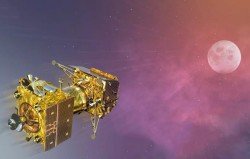Science & Technology
-labels1657453950.png)
Scientists working in an underground lab, Large Hadron Collider (LHC), have discovered three new sub-atomic particles, which are even smaller than an atom, the European Council for Nuclear Research (CERN) reported on Tuesday. Those new particles are “pentaquark” and the first-ever pair of “tetraquarks”, which includes a new type of tetraquark.
LHC is the largest machine humanity has ever created, ironically, to look for the smallest particles in the universe. It is a 27-kilometre-long tube inside a tunnel under France–Switzerland border near Geneva that accelerates the particle beam in opposite direction near to the speed of light and subsequently collide them to look for the constituents.
The most powerful particle accelerator which also proved the existence of ‘Higgs’ boson also dubbed as the ‘God particle’ back in 2012 is now in the hunt for these exotic particles following nearly three years of upgrade.
The discovery was under the experiment Large Hadron Collider beauty (LHCb), which specializes in investigating matter and antimatter by studying a type of particle called ‘beauty quark’, or ‘b quark’. Quarks are elementary particles which come in six flavours: up, down, charm, strange, top and bottom and are the building blocks of particles like protons and neutrons making our universe.
Scientists at CERN also expect that it will also help to better understand conventional hadrons and how quarks bind together into these composite particles like protons and neutrons.
 labels1657453950.png)
“The more analyses we perform, the more kinds of exotic hadrons we find,” says LHCb physics coordinator Niels Tuning in the statement by CERN. “We’re witnessing a period of discovery similar to the 1950s, when a ‘particle zoo’ of hadrons started being discovered and ultimately led to the quark model of conventional hadrons in the 1960s. We’re creating ‘particle zoo 2.0’.”
“Finding new kinds of tetraquarks and pentaquarks and measuring their properties will help theorists develop a unified model of exotic hadrons, the exact nature of which is largely unknown,” LHCb spokesperson Chris Parkes says in the statement.







